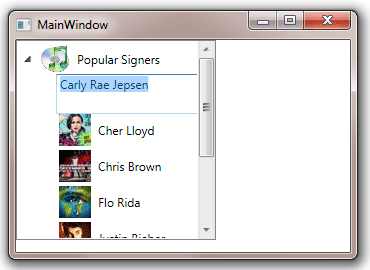Table of Contents
- Getting Started
- EO.Pdf
- EO.Web
- EO.WebBrowser
- EO.Wpf
- Overview
- Installation & Deployement
- Skin & Theme
- Common Taskes and Services
- EO.Wpf Buttons
- EO.Wpf Calendar & DatePicker
- EO.Wpf ComboBox
- EO.Wpf DockView
- EO.Wpf Gauge
- EO.Wpf ListBox
- EO.Wpf Menu
- EO.Wpf MaskedEdit
- EO.Wpf ProgressBar
- EO.Wpf Slider
- EO.Wpf SpinEdit
- EO.Wpf SplitView
- EO.Wpf TabControl
- EO.Wpf TreeView
- EO.Wpf Utility Controls
- EO.Wpf WindowChrome
- Sample Data Objects
- Common Topics
- Reference
| Node Editing |
EO.Wpf TreeView supports in place node editing. To enable this feature, simply set AllowEditItem to true for the TreeView or for a TreeViewItem. The following example sets it on the TreeView. Sample code for this topic is based on populating TreeView from hierarchical data source. So you may want to familiar yourself with that section first.
<Window x:Class="Test.MainWindow" xmlns="http://schemas.microsoft.com/winfx/2006/xaml/presentation" xmlns:x="http://schemas.microsoft.com/winfx/2006/xaml" xmlns:eo="http://schemas.essentialobjects.com/wpf/" Title="MainWindow" Height="250" Width="350"> <StackPanel> <TextBlock TextWrapping="Wrap" Margin="0,0,0,10"> This sample demonstrates how to use the inplace editing feature of a TreeView. </TextBlock> <eo:TreeView x:Name="TreeView1" AllowEditItem="True" Width="200" Height="200" HorizontalAlignment="Left" eo:TreeViewItem.EnterEditMode="TreeView_EnterEditMode" eo:TreeViewItem.ExitEditMode="TreeView_ExitEditMode"> <eo:TreeView.ItemTemplate> <HierarchicalDataTemplate ItemsSource="{Binding Path=Celebrities}"> <Grid> <Grid.ColumnDefinitions> <ColumnDefinition></ColumnDefinition> <ColumnDefinition></ColumnDefinition> </Grid.ColumnDefinitions> <eo:Bitmap Grid.Column="0" Source="{Binding Image}" Margin="2"></eo:Bitmap> <TextBlock Grid.Column="1" Text="{Binding Name}" VerticalAlignment="Center" Margin="5"></TextBlock> </Grid> <HierarchicalDataTemplate.ItemTemplate> <DataTemplate> <Grid> <Grid.ColumnDefinitions> <ColumnDefinition></ColumnDefinition> <ColumnDefinition></ColumnDefinition> </Grid.ColumnDefinitions> <eo:Bitmap Grid.Column="0" Source="{Binding Image}" Margin="2"></eo:Bitmap> <TextBlock Grid.Column="1" Text="{Binding Name}" VerticalAlignment="Center" Margin="5"></TextBlock> </Grid> </DataTemplate> </HierarchicalDataTemplate.ItemTemplate> </HierarchicalDataTemplate> </eo:TreeView.ItemTemplate> </eo:TreeView> </StackPanel> </Window>
Run the above code, then follow the following steps to edit an item:
- Select an item;
- Click the item again, - or -
- Press F2;
This places the item into edit mode as shown in the following image:

By default, the TreeView treats the TreeViewItem's Header as text and edits that text, this works if the data item is indeed a string. In case your data item is a complex object as shown in the above example, you must handle the TreeViewItem's EnterEditMode and ExitEditMode event:
- Inside the EnterEditMode event handler, you should set the EditItemEventArgs's Text property to the text you wish to edit based on your data object. In another word, Text property should contain the initial value of the editing textbox. In the above sample, it sets the Text property to the Celebrity or CelebrityCategory object's Name;
- Inside the ExitEditMode event handler, you should update your data object based on the value of the EditItemEventArgs's Text property, which now contains the text modified by the user. Additionally, You must set EditItemEventArgs's Canceled to true to cancel the default behavior for this event --- which updates the TreeViewItem's Header property to the new text;
In order for the TreeViewItem to update its UI after you modify the data object, your data object should usually implement INotifyPropertyChanged interface.
In the above sample, the editing textbox occupies the TreeViewItem image area. If you do not wish the textbox to occupy the image area, you can use the built-in TreeViewItem Icon support to render tree view icon images.

